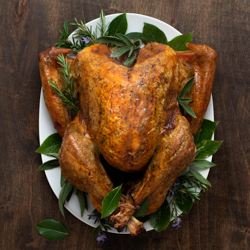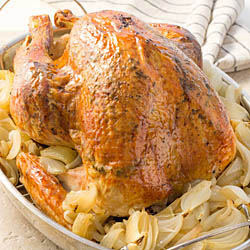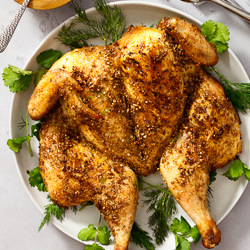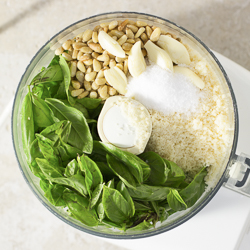Perhaps you’ve wondered about that bready treat we regularly enjoy for Thanksgiving—why do some call it stuffing and others call it dressing? What’s the difference?
Here’s the dish.
Generally speaking, “stuffing” and “dressing” are interchangeable. Technically speaking, however, they mean different things. And further complicating it all, which one you make and how you refer to it might depend on where you’re from.
So what’s the difference?
Stuffing and dressing are both mixtures of dried bread cubes (or sometimes other carbs like rice or grains), onions and/or other veggies, herbs, butter, broth, and possibly additional goodies. My Apple and Parmesan Dressing, for example, includes—surprise!—apples and parmesan.
Technically speaking, however, stuffing is, well, stuffed. It cooks in the cavity of a turkey or chicken. It’s wrapped up in a roast. It’s pushed into the pocket of a pork chop or chicken breast. Or it fills something else, like a bell pepper, a halved acorn squash, or a bunch of mushrooms.
Dressing, on the other hand, is cooked separately, typically in a casserole dish or baking pan—although there is, of course Stove Top Stuffing (which you now know isn’t technically stuffing at all!).
All that said, the difference between the two might depend on where you’re from. If you’re from the South, for example, no matter how it’s cooked you probably call it dressing. And if you’re from the Northeast or West, you probably call it stuffing.
So which is better?
Since stuffing is cooked inside something, it has the benefit of absorbing the flavors of that something. For example, stuffing in a turkey is essentially basted in the yummy turkey juices. Add that to the plus column for stuffing.
But in the minus column—those are turkey juices are raw, so you need to cook that turkey long enough to get the very center of the juice-basted stuffing to the same temperature that you need to cook the meat (165°F). Which could mean that the not-so-center parts—the breasts, for example—are overcooked and dry.
For that reason alone, if I want a bready side dish for a bird or any other raw meat with a cavity, I prefer dressing to stuffing.
Another minus to a stuffing-filled cavity? During the last-minute rush of carving and serving, the last thing I want to do is also dig that stuffing out of there.
All minuses of stuffing go away, however, when you’re not stuffing raw meat. For a stuffed pepper, squash, or mushroom, for example, assuming there are no raw proteins in the stuffing itself, you only need to cook the stuffee long enough to get the stuffing hot.
The minuses of stuffing also go away if the stuffing is thinly laced through your raw meat—in a spiral-cut roast, for example. In a recipe like that, the stuffing doesn’t particularly add to the overall cooking time, so it doesn’t risk the meat being overcooked and dry. The stuffing is also served as part of the meat, so it doesn’t have to be scraped out to be served.
On the plus side for dressing, besides that it cooks separately and doesn’t affect the cooking time of your meat, is that it’s usually finished uncovered. So it can brown and crisp in a way that stuffing never will.
The biggest minus of dressing? Also because it cooks separately, dressing means having to squeeze one more dish into a potentially already-crowded oven. And that can be a challenge—especially on Thanksgiving.
Bottom line
Stuffing is stuffed inside something, which can have flavor advantages. But if that something is raw meat, you have to cook that meat long enough for both the meat and the stuffing to reach a safe internal temperature. Which can lead to overcooked meat.
Dressing is cooked on its own, which means you can cook it and whatever you’re serving it with perfectly, including a nicely browned top on the dressing. But dressing also means one more dish in the oven.
For me, the scales tip to dressing almost every time. But—I have two ovens. :)
Stuffed and unstuffed roasts and sides for the holidays:
Apple and Parmesan Dressing
Simple Herby Dry-Brined Turkey
Classic Roast Chicken with Roast Potatoes
Lemon- and Prosciutto-Stuffed Pork Loin
Pomegranate Rack of Lamb with Garlic and Rosemary
Mixed Greens with Pears, Bacon, Gruyère, and Warm Mustard Vinaigrette
Spinach Salad with Cranberries and Pecans
Roasted Brussels Sprouts and Potatoes with Lemon and Rosemary
Cumin-Roasted Potatoes
Cranberry and Apple Sauce
Pumpkin Pie with Gingered Whipped Cream












